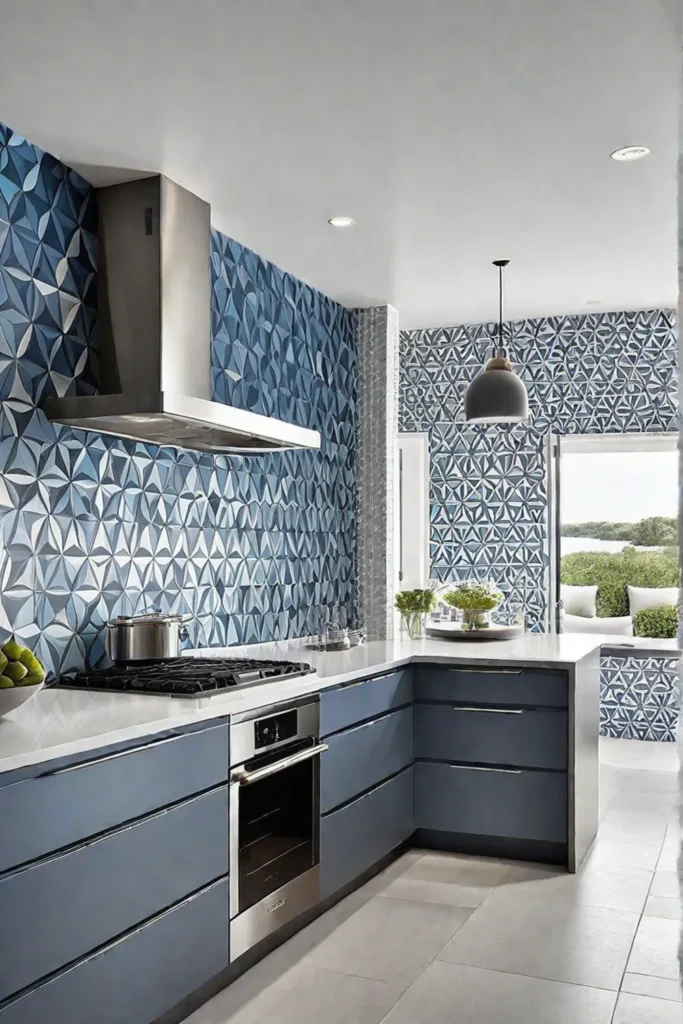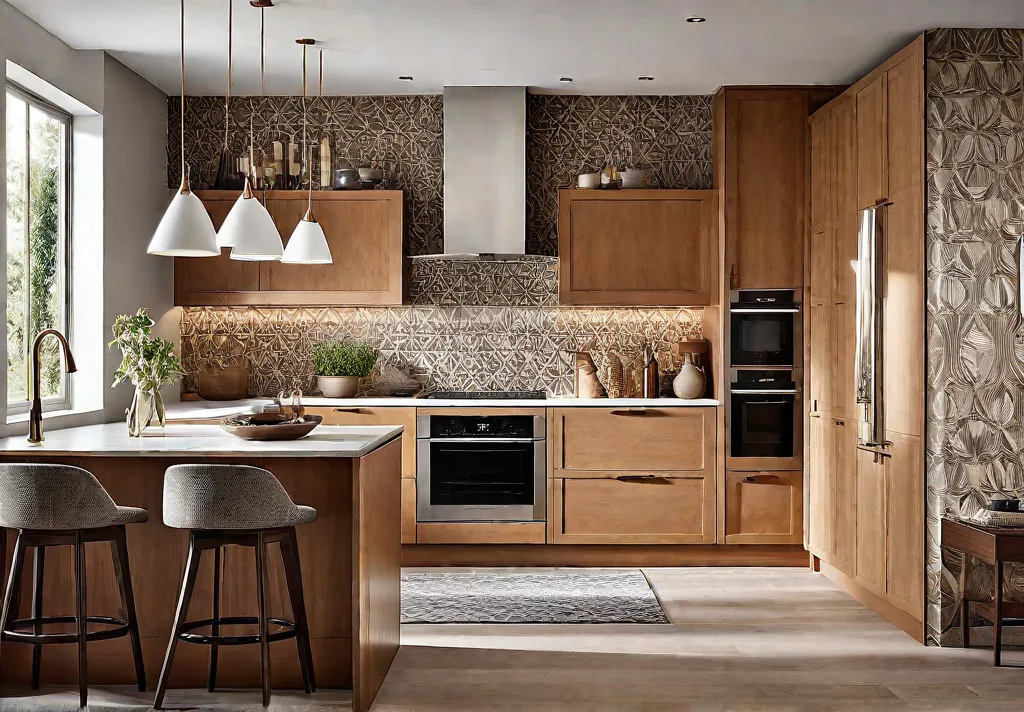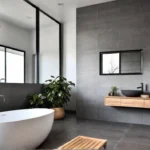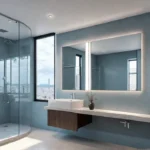Have you ever stepped into a space and felt an instant connection, like it was speaking directly to your soul? That’s the magic of thoughtful design. In modern kitchen decor, the key to creating a space that truly resonates is the harmonious interplay of color, pattern, and texture. From bold wallpaper statements to carefully curated material combinations, every element works in tandem to evoke emotion and tell a story.

So join me on a journey of elevated aesthetics, where we’ll explore the art of mastering color palettes, pattern play, and textural depth. Together, we’ll unlock the secrets to achieving design cohesion that transforms your kitchen into a captivating oasis of style and self-expression. Get ready to be inspired!
Understanding Color Palettes
Have you ever stepped into a room and felt instant calm or energy? That’s the power of color at work! As an interior designer, understanding color theory is essential for creating spaces that look beautiful and evoke specific moods and emotions.
Warm vs. Cool Tones
Colors can be broadly categorized into warm and cool tones. Warm tones like reds, oranges, and yellows create a cozy, inviting atmosphere, while cool tones like blues, greens, and purples can have a more calming and refreshing effect. Consider the ambiance you want to create when selecting colors for your modern kitchen.

Monochromatic, Analogous, and Complementary Schemes
One way to approach color selection is through color schemes. Monochromatic schemes use shades and tints of a single hue, creating a cohesive and harmonious look. Analogous schemes combine colors adjacent to the color wheel, creating a seamless blend. Complementary schemes, on the other hand, use colors that are opposite on the color wheel, creating a bold and vibrant contrast.
Identifying Dominant, Secondary, and Accent Colors
When working with color palettes, it’s important to identify the dominant, secondary, and accent colors. The dominant color sets the overall tone, the secondary color provides support, and the accent adds visual interest and depth. This hierarchy helps create a balanced and visually appealing space.
Warm colors like reds and oranges can make a kitchen feel cozy and inviting, while cool tones like blues and greens create a more refreshing and calming atmosphere. As for popular trends, bold and saturated colors are returning, adding a touch of drama to modern kitchen designs.

Understanding color relationships is crucial for successful pattern mixing and creating cohesive and visually appealing kitchens. By mastering color theory and exploring different palettes, you can transform your kitchen into a space that looks stunning and reflects your style and mood.
Speaking of patterns, let’s dive into the world of pattern scales and how they can add depth and interest to your kitchen design.
Playing with Pattern Scales
As an expert in home decor, I know that mixing different pattern scales is a surefire way to add depth and visual interest to your modern kitchen. But how do you strike the perfect balance? Let’s dive into the world of pattern play!
The Impact of Pattern Size on Space Perception
Pattern scale has a profound effect on how we perceive space. Large, bold patterns can make a small kitchen feel more open and airy, while small, intricate designs add texture and detail without overwhelming the space. It’s all about finding the right mix to create the desired ambiance.

Mixing Patterns of Different Scales
The key to mastering pattern play is to harmoniously mix and match different scales. Start with a large-scale statement piece, like a bold wallpaper on a feature wall or a striking backsplash, and then complement it with smaller-scale patterns in your cabinet hardware, textiles, or accessories.
When it comes to the optimal ratio of large to small-scale patterns, there’s no one-size-fits-all rule. It depends on the overall look you’re going for and the size of your kitchen. Aim for one or two large-scale patterns balanced with several smaller-scale accents as a general guideline.
Creating Focal Points with Pattern Scale
Pattern scale is also a powerful tool for creating focal points in your kitchen design. A large-scale wallpaper or tile backsplash can draw the eye to a specific area, while smaller-scale patterns can subtly guide the gaze around the room. Play with contrast and balance to highlight your favorite features and create a cohesive, visually appealing space.
Remember, the key to pattern play is experimentation and balance. Don’t be afraid to mix and match different scales, but always step back and assess the overall look to ensure a harmonious and inviting kitchen design.

Speaking of creating depth and texture, let’s move on to the next section: Exploring Texture Combinations. Layering different materials and finishes can add another interest to your modern kitchen, but it’s important to strike the right balance.
Exploring Texture Combinations
Have you ever run your fingers across a smooth marble countertop or felt the intricate grooves of a rustic wood cabinet? Texture adds a tactile dimension to visual aesthetics, engaging our senses and creating depth within a space. Combining different textures can elevate the overall ambiance and sophistication in modern kitchen design.

Visual and Tactile Textures
Texture plays a crucial role in interior design, influencing the perception of light and shadow. Visual textures, like the intricate patterns of wallpaper or the sleek finish of glass, create a sense of depth and movement. Tactile textures, on the other hand, invite us to explore the space through touch, whether it’s the smooth coolness of marble or the rough warmth of natural wood.
Mixing Smooth and Rough Textures
Combining smooth and rough textures is one of the most effective ways to add interest and dimension to your kitchen. Imagine the contrast of a sleek, glossy backsplash against the rustic charm of distressed wooden cabinets. This juxtaposition creates a dynamic interplay that captivates the eye and adds an inviting, layered quality to the space.
Achieving Textural Harmony
While contrasting textures can be visually striking, finding a balance that avoids overwhelming the senses is essential. Consider introducing a unifying element, like a subtle wallpaper pattern that ties together the different materials and textures. By thoughtfully curating texture combinations, you can create a cohesive and engaging kitchen environment that feels visually appealing and inviting.

Texture adds a tactile dimension to visual aesthetics, and thoughtful texture combinations create a dynamic and engaging kitchen environment. As we transition to the next section, consider how texture can seamlessly integrate with color and pattern to achieve design cohesion.
Achieving Design Cohesion
Have you ever walked into a beautifully designed kitchen and felt a sense of harmony and balance? That’s the power of design cohesion – creating a unified and stylish space that feels intentional and well-thought-out.

Repeating Patterns and Motifs
One of the most effective strategies for achieving design cohesion is to repeat patterns and motifs throughout the space. You create a visual thread that ties the entire room by incorporating the same wallpaper pattern in your window treatments or upholstery. This repetition creates a sense of order and harmony, making the space feel cohesive and inviting.
Maintaining a Cohesive Color Story
In addition to patterns, maintaining a consistent color story is crucial for achieving design cohesion. Use the accent colors from your modern kitchen wallpaper as inspiration and incorporate them throughout the space. Whether in the form of colorful accessories, textiles, or even small appliances, this consistent use of color will create a sense of unity and flow.
Establishing a Consistent Design Style
Finally, establishing a consistent design style is key to achieving design cohesion. Whether you prefer a sleek and modern aesthetic or a warm and rustic vibe, ensure that all elements in your kitchen align with that chosen style. From the wallpaper to the cabinetry, countertops, and lighting fixtures, every detail should work together to create a cohesive and harmonious space.

By repeating patterns, maintaining a cohesive color story, and establishing a consistent design style, you can transform your kitchen into a true masterpiece of design cohesion. And who knows, you might find yourself lingering a little longer in this beautifully coordinated space.
What are some effective strategies for achieving design cohesion when mixing modern kitchen wallpaper with your existing decor? The key lies in pattern coordination, color harmony, and embracing a consistent design style throughout the space.
Harmonizing Wallpaper with Existing Decor
Does your kitchen need a fresh, modern update, but you’re hesitant to overhaul the entire space? Introducing wallpaper can be a game-changer, allowing you to breathe new life into your existing decor while maintaining the elements you love.

Identifying Common Design Elements
Identifying common threads is the key to seamlessly integrating wallpaper into an established design scheme. Retake and analyze the colors, textures, and styles currently defining your kitchen. Perhaps your cabinets boast a rich, warm wood tone, or your light fixtures exude a mid-century modern flair. You can select a wallpaper pattern that complements and enhances the existing aesthetic by pinpointing these unifying elements.
Adapting Wallpaper Choices to Existing Styles
Once you’ve identified the dominant design elements, it’s time to explore wallpaper options that will harmonize with your current decor. If your kitchen leans towards a traditional or farmhouse style, consider wallpapers with classic patterns like toile or damask in fresh, modern colorways. For a more contemporary vibe, geometric or abstract prints can add visual interest while maintaining a cohesive look.
Complementing Existing Furniture and Finishes
Beyond just style, it’s essential to consider the specific colors and finishes already present in your kitchen. For example, if your cabinets are deep navy blue, a wallpaper with complementary shades of blue or contrasting hues like warm oranges or yellows can create a stunning, cohesive palette. Similarly, if your kitchen boasts sleek, stainless steel appliances, a wallpaper with metallic accents or a subtle sheen can tie the space together beautifully.

Integrating wallpaper into an existing design scheme is all about striking a balance. By carefully considering the elements you love and introducing a wallpaper that harmonizes with those elements, you can create a fresh, modern kitchen that feels like a natural extension of your style.
Conclusion
In the realm of modern kitchen design, the possibilities for self-expression are truly limitless. By mastering the art of color palettes, pattern play, and textural combinations, you can create a space that looks stunning and feels like an extension of your unique personality.

Remember, the true essence of great design lies in the harmonious balance of elements, where each detail complements the next, weaving together a tapestry of beauty and functionality. So embrace your creativity, trust your instincts, and let your kitchen become a canvas for your boldest design dreams.
After all, a well-designed space can transform the ordinary into the extraordinary, turning everyday moments into cherished memories. So what are you waiting for? Unlock the door to your dream kitchen today and let your style shine!






